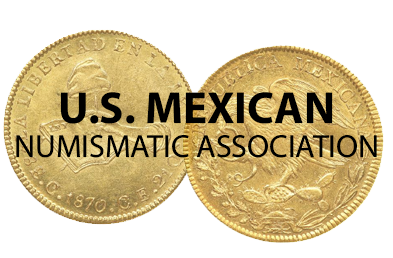One peso coins (1910-1987)
The one peso coins were made in nine basic types
Type 1 – Caballito
Type 2 - .800
Type 3 - .720
Type 4 – Little Morelos
Type 5 – General Morelos
Type 6 – Constitution
Type 7 - .100
Type 8 – Copper-nickel
Type 9 – Steel
Type 1 – Caballito
KM-453
For a variety of reasons, that are discussed here, there were no new one peso coins until 1910, when the Caballito was issued. These were composed of 90.27% silver and 9.73% copper, and had a diameter of 39 mm and a weight of 27.09 g. Mintage was
| Year | Mintage | |
| 1910 | 3,814,000 | short ray |
| 1911 | 1,227,000 | short ray, long ray |
| 1912 | 322,000 | |
| 1913 | 2,880,000 | 1913/12 overdate |
| 1914 | 120,000 |
There are further details about the different year dates here.
According to Antonio Deana Salmerón, “In the proofs of the one-peso coin it was noticed that on both sides they had too much relief, so that they could not be stacked as was the custom for counting, and he [the French engraver Charles Pillet] was asked to retouch these instruments, for which he was annoyed and at first refused to make the corresponding adjustments. He argued that no one could get his hands on his work, enforcing his copyright.
Faced with this situation, the Minister of Finance, José Yves Limantour, commissioned Francisco Valdés to be in charge of settling this matter and, in fact, Valdés traveled to Paris and met with Charles Pillet, informing him that as the Government of Mexico had paid him for the work that he did, it remained the property of the Nation and therefore the Government was free to proceed as it saw fit. Faced with this evidence, Pillet changed his mind and asked for 3,000 francs to do the work again, a proposal that the Mexican commissioner did not accept, returning to Mexico with all the instruments. Time was pressing, so Valdés traveled to the United States and met with Charles Barber, Chief Engraver of the Philadelphia Mint, who finally made the necessary retouching and adjustments to the dies and dies of the coin, a job for which he charged the sum of $1,000 dollars; but in the end this instrument was ready to begin the long-awaited minting, which began at the Mint in 1910." Antonio Deana Salmerón, Las Monedas de un peso de 1910 a 1914 no ostentan la marca de Ceca o de México,
On 27 December 1909 the decree authorizing the coin was issued and on 12 January 1910 the minting began.
PradeauAlberto F. Pradeau, Numismatic History of Mexico, vol. 1 mentions that adjustments that were made to the currency before its issue. "The repair and adjustment work of Pillet had two problems, its high cost and that its technique did not conform to the standards of the Mint, so it was preferred to work with Charles Barber of the Philadelphia Mint. The Minister of Finance, José Y. Limantour, approved the changes. Pillet protested that these changes were made by someone else, however, in his original contract nothing was mentioned about artistic property. On 16 November 1910, Limantour issued the guidelines to be obeyed in Philadelphia. On 2 February 1911, the changes were completed." Pradeau adds that "by order of the Ministry of Finance, issued on 12 January 1910, the Mexican Mint had to mint five million of these $1 coins. Thereafter, the sums authorized and the amounts manufactured were as follows":
| Date of order | Total authorized | Quantity minted | Date on coin |
| 12 January 1910 | $5,000,000 | $4,506,000 | 1910 |
| 11 August 1910 | $1,500,000 | $847,000 | 1911 |
| 601,000 pieces were produced without an order | $1,748,000 | 1912 | |
| 4 March 1913 | $2,000,000 | ||
| 10 June 1913 | $500,000 | $762,000 | 1913 |
| September 1913 | $700,000 | $500,000 | 1913-1914 |
| $9,700,000 | $8,363,000 |
The last order of the Ministry of Finance cancelled the minting orders that had been previously issued and foresaw the minting of 700,000 pieces, of which 380,000 were produced in the course of October and November 1913 and 120,000 more pieces were minted in March 1914.
Luis Gómez Wulschner has provided the following information regarding the number of dies used to produce this series:
| January 1910 to July 1911 | 168 obverse (117 used) and 188 reverse (139 used) |
| May, July, December 1912 ( the only months of minting) | 13 obverses and 15 reverses were manufactured |
| March, April and May 1913 (the only months of minting) | 27 obverses (15 obverses are used) and 40 reverses (13 verses are used) |
| March 1914 (120,000 pieces produced) | 11 obverse and 10 reverse are manufactured |
By 1910 26,826 pieces were minted per pair of stamps, later in 1912 and 1913 124,857 pieces were minted per pair of stamps. At this time due to the lack of stamps, old stamps that had not been used were used, thus generating overdates. Throughout the series, 263 dice are manufactured for the obverse and 309 for the reverse, but only 196 are used for the obverse and 203 for the reverse.
Type 2 - .800
On 13 November 1918 Venustiano Carranza reduced the silver content of Mexico’s coins. The reason given in his decreeDiario Oficial, 14 November 1918 were that
(a) as a result of the rise in the global price of silver, the pesos fuertes had long since been driven out from circulation, and the functions of the fractional silver coinage had been hindered by their increasing tendency to disappear;
(b) this was due to unavoidable economic causes, and so the government was unable to prevent the disappearance of the fractional coinage. The remedy was, therefore, to reduce the quantity of pure silver contained in the fractional coin in such a way that there was no inducement to export, recast or simply hide This was all the more acceptable as the fractional coinage had only a representative value, as an auxiliary to the gold coins, that were the basis of the monetary system.
(c) that, since the old silver pesos had disappeared from circulation for some time, there was no longer any reason to consider them as part of the monetary system; and that, since it was desirable to fractional coins worth one peso, it was necessary to demonetize the old silver pesos, thus completing and consolidating the monetary regime established on 25 March 1905, through the country's definitive entry into gold monometallism.
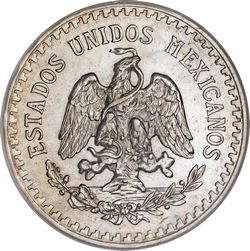
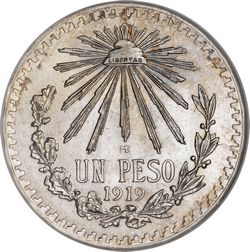
KM-454 1919 $1
The new pesos were composed of 80% silver and 20% copper, and had a diameter of 34 mm and a weight of 18.125 g. Mintage was 3,050,000 in 1918 and 6,151,000 in 1919.
There was an 8 over 7 overdate.
When Plutarco Calles authorised the new 10c coin in 1925, he also decreed that the silver 10c, 20c, 50c and $1 coins created by the 13 November 1918 law should be legal tender up to the end of 1925Diario Oficial de la Federación, Tomo XXX, Núm. 3, 6 May 1925.
Type 3 - .720
On 27 October 1919 Venustiano Carranza noted that the continuing rise in the price of silver threatened the disappearance of the one-peso, fifty-, twenty-, and ten-centavo coins created by the previous year’s law, and that the government needed to ensure a supply of such coinage to maintain daily commercial transactions, and so issued a new decree, altering the composition of the 20c, 50c and $1 coins and introducing a new bronze 10c pieceDiario Oficial, 31 October 1919.
KM-455
These had a reduced fineness of 72% silver and 28% copper and weighed 16.66 g. Mintage was
| Year | Mintage | |
| 1920 | 8,830,000 | |
| 1921 | 5,480,000 | |
| 1922 | 33,620,000 | |
| 1923 | 35,280,000 | |
| 1924 | 33,060,000 | |
| 1925 | 9,160,000 | |
| 1926 | 28,840,000 | |
| 1927 | 5,060,000 | |
| 1932 | 50,770,000 | |
| 1933 | 43,920,000 | for a detailed study of the 1933 coin see here |
| 1934 | 22,070,000 | |
| 1935 | 8,050,000 | |
| 1938 | 30,000,000 | |
| 1940 | 20,000,000 | |
| 1943 | 47,622,000 | |
| 1944 | 39,522,000 | |
| 1945 | 37,300,000 |
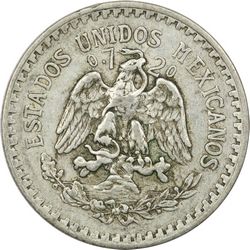
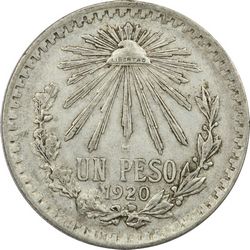
KM-455 1920 $1 20 over 10
Type 4 – Little Morelos "Cacheton"
On 11 September 1947 Miguel Alemán changed the specifications for the 50c, $1 and $5 silver coinsDiario Oficial de la Federación, Tomo CLXIV, Núm. 16, 19 September 1947.
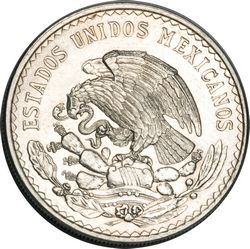
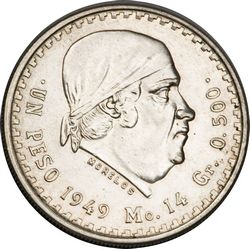
KM-456 1949 $1
These were nicknamed "chacetón" (plump-cheeked) because of Morelos' appearance. They were 50% silver, 40% copper, 6% nickel and 4% zinc. They had a diameter of 32 mm and weight of 14 g. Mintage was
| Year | Mintage | |
| 1947 | 61,460,000 | |
| 1948 | 22,915,000 | |
| 1949 | 4,000,000 |
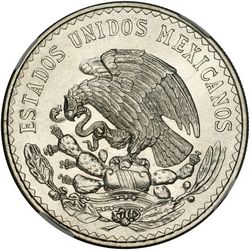
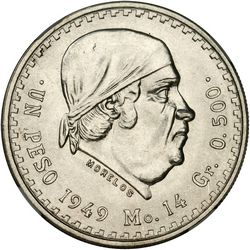
KM-456 1949 $1 (Stack’s Bowers NYINC auction, 8 January 2013,lot 1565)
According to Neil UtnergNeil S. Utberg, The Coins of United Mexican States, 1965 "The 1949 peso is the rarest modern coin in Mexico, 2,000,000 of the total issue were die-cut at the Denver mint, but it is not known if these pieces were cast in Denver or sent to Mexico for casting. Due to the devaluation of the Mexican Peso, these coins came to contain more than one peso in silver value, so the 1949 peso was not officially released into circulation.”. Pablo Luna Herrera has stated that, according to official documentation issued by the Mexican mint itself as well as the American mint. the total mintage of the 1949 coin (4,000,000) was minted at the Mexican Mint in Mexico City, not by the North American mints of Denver and/or San Francisco.
Type 5 – General Morelos
On 29 December 1949, after the devaluation of the peso, Miguel Aleman issued a decree changing the designs of the denominations up to and including the $1 valueDiario Oficial de la Federación, 30 December 1949.
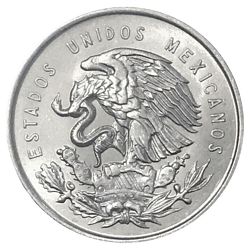
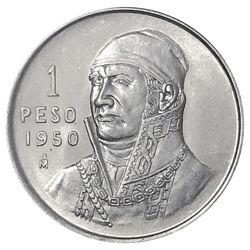
KM-457 1950 $1
The $1 coin had a lower silver content and size. These were 50% copper, 30% silver, 10% nickel and 10% zinc. They had a diameter of 32 mm and weight of 13.33 g.
Mintage was 3,287,000 in the single year, 1950. For this, more than 15,000,000 of the earlier $1 coins were melted down, although it is not known from what dates.
Type 6 – Constitution
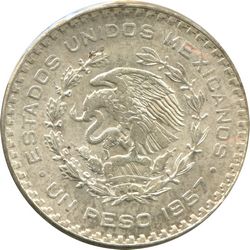
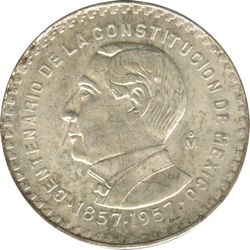
KM-458 1957 $1
In 1957, to commemorate the 100th anniversary of the 1857 Constitution, the government minted five gold and silver coins, almost all with the bust of Benito Juárez. The $1 coin were 70% copper, 10% silver, 10% nickel and 10% zinc. They had a diameter of 34.5 mm and weight of 16 g. Mintage was 500,000 in 1957.
These weere authorised by the decree of 31 December 1956.
Type 7 - .100
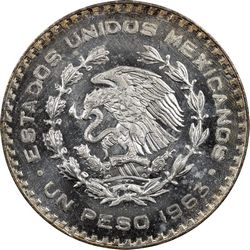
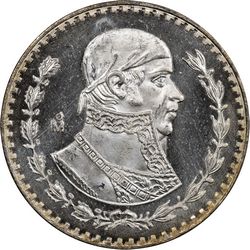
KM-459 1963 $1
This coin was approved by the decree of 31 December 1956.
These were also 70% copper, 10% silver, 10% nickel and 10% zinc, with a diameter of 34.5 mm and weight of 16 g. Mintage was
| Year | Mintage | |
| 1957 | 28,273,000 | |
| 1958 | 41,899,000 | |
| 1959 | 27,369,000 | |
| 1960 | 26,259,000 | |
| 1961 | 52,601,000 | |
| 1962 | 61,094,000 | |
| 1963 | 26,394,000 | |
| 1964 | 15,615,000 | |
| 1965 | 5,004,000 | |
| 1966 | 30,998,000 | |
| 1967 | 9,308,000 |
Type 8 – Copper-nickel
On 27 December 1969 Gustavo Díaz Ordaz authorised a new series of coinage from the one centavo to the twenty-five pesoDiario Oficial, 30 December 1969.
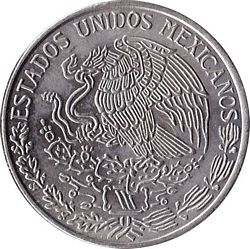
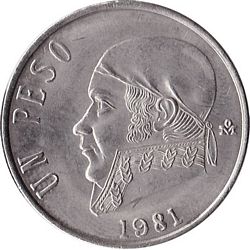
KM-460 1981 $1
After two years of absence of this denomination in 1970 a new coin was introduced, smaller in weight (9 g) and diamete (29 mm), also without any precious metal, being made of cupronickel. (75% copper and 25% nickel).
| Year | Mintage | |
| 1970 | 102,715,000 | narrow date, wide date |
| 1971 | 426,222,000 | |
| 1972 | 120,000,000 | |
| 1974 | 63,700,000 | |
| 1975 | 206,979,000 | narrow date, wide date |
| 1976 | 94,489,000 | |
| 1977 | 94,364,000 | thick date, thin date |
| 1978 | 55,140,000 | open 8 |
| 208,300,000 | closed 8 | |
| 1979 | 117,884,000 | thick date, thin date |
| 1980 | 318,800,000 | closed 8, wide date |
| 23,865,000 | closed 8, narrow date: open 8 | |
| 1981 | 58,616,000 | closed 8, narrow date: open 8, wide date: closed 8, open 9: closed 8 and 9 |
| 1982 | 235,000,000 | 8 open at the base |
| 1983 | 100,000,000 | wide date, narrow date, open 8 |
Type 9 – Steel


KM-496 1984 $1
.
After the devaluations of 1976, 1981 and 1982, the following year a new 1 peso coin, smaller and in stainless steel, was introduced. This was approved by the decree of 30 December 1983. It had a diameter of 34.5 mm and weight of 6.07 g. Mintage was
| Year | Mintage | |
| 1984 | 722,802,000 | engraver’s initials, no initials |
| 1985 | 985,000,000 | |
| 1986 | 740,000,000 | |
| 1987 | 250,000,000 |
Mint error
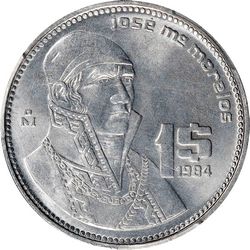
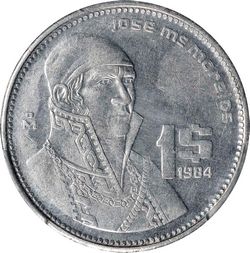
KM-486 1984 $1 with two reverse dies (Stack’s Bowers auction, 15 November 2022, lot 72902)
